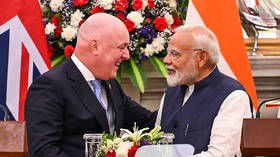Big powers ‘play with fire’ dragging feet in reducing nuclear arsenals – Ex-IAEA head to RT
Nearly 20,000 warheads owned by big powers with “sparks flying” between them are more risky than “dirty bombs” in hands of terrorist organizations, Hans Blix and Lassina Zerbo, reputed international experts on nuclear security, told RT.
Hans Blix, a renowned Swedish diplomat who led the UN’s International Atomic Energy Agency for more than 16 years, and headed the monitoring mission sent to Iraq in search of alleged weapons of mass destruction prior to the 2003 Iraq War, has described the biggest threats posed by nuclear weapons to RT in an exclusive interview.
Recalling the end of the Cold War, which was marked by massive disarmament efforts between the USSR and US, Blix said it was “the great time” that resulted in several milestone agreements banning nuclear tests and chemical weapons.
“Since then we’ve had hopes that countries would go on, with President Obama [pushing for] the nuclear-free world. But since 2010, when an agreement was reached between Russia and the United States about the START treaty [reducing number of warheads and weapons carriers], things have gone badly.”
Twenty years after the Comprehensive Nuclear-Test-Ban Treaty (CTBT) was adopted by the UN in 1996, which urges all countries to abandon nuclear detonations for both military and civilian purposes, “the atmosphere in the world became chilly,” Blix said, warning that major powers have once again entered a phase of pumping large sums of money into rearmament.
Despite Washington’s countless promises to ratify the CTBT, last year Moscow accused the US of taking “no practical steps” in that direction, consequently preventing the important agreement from entering into force.
While both countries have nuclear arsenals sufficient for mutually assured destruction, only Russia has either signed or ratified the treaty.
Very constructive concrete mtg w/ Deputy FM #Ryabkov, #GEM member Hans #Blix@SinaZerbo@mfa_russiapic.twitter.com/pMvtNKF37d
— CTBTO (@ctbto_alerts) April 19, 2016
Lassina Zerbo, Executive Secretary of the Comprehensive Nuclear-Test-Ban Treaty Organization (CTBTO), agreed with Blix, saying “the horizon is not that bright, North Korea is still testing [alleged nuclear weapons], the CTBT is not in force or yet to enter into force while there is no strong leadership to bring the parties together and discuss [arms control-related] issue.”
Whereas many around the globe, understandably, believe the prospect of terrorists acquiring crude nuclear weapons, also known as “dirty bombs,” presents the biggest threat to the world, Zerbo argued that this concern “should not hide the unfinished business” of preventing a new arms race.
Warm welcome @ #UN house Moscow mtg country team @UNIC_Moscow 2 talk #ctbt20, civil society, #youth, UN cooperation pic.twitter.com/aKAFit0EKa
— CTBTO (@ctbto_alerts) April 19, 2016
“I think there is a tendency among the great powers to say that we are responsible and not dangerous, it’s these terrorists who might get plutonium and make a dirty bomb,” Blix explained.
“We should remember that there are a little less than 20,000 nuclear warheads still around and they’re not in the hands of terrorists, they’re in the hands of big powers. And the big powers are pretty close to each other. The military has its body language, and we see it over the Baltic and the North Sea, so in this language you have sparks flying which is a very dangerous thing.”
As NATO’s massive Eastern European build-up at Russia’s doorstep continues, Moscow says the bloc has also moved aircraft capable of delivering nuclear weapons closer to its border.
NATO destabilizing Baltic by stationing nuke-capable aircraft – Moscow
Blix claimed that, although the chances of terror groups like IS obtaining “dirty bombs” are slim, attempts by terrorists to acquire nuclear materials still needs to be tracked.
As a terror weapon, a “dirty bomb” can create contamination, but its effect would still pale compared to that of a nuclear weapon, he elaborated. “Yes, that’s bad … but the nuclear bombs are much worse.”
“You can hardly say that the risks are zero, they use plutonium and cesium from hospitals and theoretically try to put such things together. But you should not see a ‘dirty bomb’ as something equal to a nuclear bomb. The nuclear bomb is something horrendous what we know from Hiroshima and Nagasaki.”
The US, which dropped nuclear bombs on Japan in 1945, is believed to be dragging its feet in destroying its stockpiles of weapons-grade plutonium, which it is obligated to do under a bilateral Russian-American agreement. Russian President Vladimir Putin has recently accused the US of destroying the plutonium in a manner that allows it to be recycled for military use.
Blix pointed out that “this work is secret after all, they don’t tell where they are going. [I know] not more than what is published, I’m not sitting in the government, nor am I in the CIA. But I can say they should have a common interest in stopping it, because it’s playing with fire.”













